+ Open data
Open data
- Basic information
Basic information
| Entry | Database: EMDB / ID: EMD-30616 | |||||||||
|---|---|---|---|---|---|---|---|---|---|---|
| Title | human potassium-chloride co-transporter KCC3 | |||||||||
 Map data Map data | ||||||||||
 Sample Sample |
| |||||||||
 Keywords Keywords | potassium-chloride / co-transporter / TRANSPORT PROTEIN | |||||||||
| Function / homology |  Function and homology information Function and homology informationDefective SLC12A6 causes agenesis of the corpus callosum, with peripheral neuropathy (ACCPN) / potassium:chloride symporter activity / Cation-coupled Chloride cotransporters / potassium ion transmembrane transporter activity / chloride ion homeostasis / cellular hypotonic salinity response / cellular hypotonic response / potassium ion homeostasis / cell volume homeostasis / potassium ion import across plasma membrane ...Defective SLC12A6 causes agenesis of the corpus callosum, with peripheral neuropathy (ACCPN) / potassium:chloride symporter activity / Cation-coupled Chloride cotransporters / potassium ion transmembrane transporter activity / chloride ion homeostasis / cellular hypotonic salinity response / cellular hypotonic response / potassium ion homeostasis / cell volume homeostasis / potassium ion import across plasma membrane / monoatomic ion transport / potassium ion transmembrane transport / chloride transmembrane transport / cellular response to glucose stimulus / angiogenesis / basolateral plasma membrane / chemical synaptic transmission / axon / synapse / protein kinase binding / metal ion binding / membrane / plasma membrane Similarity search - Function | |||||||||
| Biological species |  Homo sapiens (human) Homo sapiens (human) | |||||||||
| Method | single particle reconstruction / cryo EM / Resolution: 3.6 Å | |||||||||
 Authors Authors | Xie Y / Chang S | |||||||||
| Funding support |  China, 1 items China, 1 items
| |||||||||
 Citation Citation |  Journal: Sci Adv / Year: 2020 Journal: Sci Adv / Year: 2020Title: Structures and an activation mechanism of human potassium-chloride cotransporters. Authors: Yuan Xie / Shenghai Chang / Cheng Zhao / Feng Wang / Si Liu / Jin Wang / Eric Delpire / Sheng Ye / Jiangtao Guo /   Abstract: Potassium-chloride cotransporters KCC1 to KCC4 mediate the coupled export of potassium and chloride across the plasma membrane and play important roles in cell volume regulation, auditory system ...Potassium-chloride cotransporters KCC1 to KCC4 mediate the coupled export of potassium and chloride across the plasma membrane and play important roles in cell volume regulation, auditory system function, and γ-aminobutyric acid (GABA) and glycine-mediated inhibitory neurotransmission. Here, we present 2.9- to 3.6-Å resolution structures of full-length human KCC2, KCC3, and KCC4. All three KCCs adopt a similar overall architecture, a domain-swap dimeric assembly, and an inward-facing conformation. The structural and functional studies reveal that one unexpected N-terminal peptide binds at the cytosolic facing cavity and locks KCC2 and KCC4 at an autoinhibition state. The C-terminal domain (CTD) directly interacts with the N-terminal inhibitory peptide, and the relative motions between the CTD and the transmembrane domain (TMD) suggest that CTD regulates KCCs' activities by adjusting the autoinhibitory effect. These structures provide the first glimpse of full-length structures of KCCs and an autoinhibition mechanism among the amino acid-polyamine-organocation transporter superfamily. | |||||||||
| History |
|
- Structure visualization
Structure visualization
| Movie |
 Movie viewer Movie viewer |
|---|---|
| Structure viewer | EM map:  SurfView SurfView Molmil Molmil Jmol/JSmol Jmol/JSmol |
| Supplemental images |
- Downloads & links
Downloads & links
-EMDB archive
| Map data |  emd_30616.map.gz emd_30616.map.gz | 47.7 MB |  EMDB map data format EMDB map data format | |
|---|---|---|---|---|
| Header (meta data) |  emd-30616-v30.xml emd-30616-v30.xml emd-30616.xml emd-30616.xml | 12.1 KB 12.1 KB | Display Display |  EMDB header EMDB header |
| Images |  emd_30616.png emd_30616.png | 63.6 KB | ||
| Filedesc metadata |  emd-30616.cif.gz emd-30616.cif.gz | 6.2 KB | ||
| Archive directory |  http://ftp.pdbj.org/pub/emdb/structures/EMD-30616 http://ftp.pdbj.org/pub/emdb/structures/EMD-30616 ftp://ftp.pdbj.org/pub/emdb/structures/EMD-30616 ftp://ftp.pdbj.org/pub/emdb/structures/EMD-30616 | HTTPS FTP |
-Related structure data
| Related structure data |  7d90MC  7d8zC  7d99C M: atomic model generated by this map C: citing same article ( |
|---|---|
| Similar structure data |
- Links
Links
| EMDB pages |  EMDB (EBI/PDBe) / EMDB (EBI/PDBe) /  EMDataResource EMDataResource |
|---|
- Map
Map
| File |  Download / File: emd_30616.map.gz / Format: CCP4 / Size: 52.7 MB / Type: IMAGE STORED AS FLOATING POINT NUMBER (4 BYTES) Download / File: emd_30616.map.gz / Format: CCP4 / Size: 52.7 MB / Type: IMAGE STORED AS FLOATING POINT NUMBER (4 BYTES) | ||||||||||||||||||||||||||||||||||||||||||||||||||||||||||||
|---|---|---|---|---|---|---|---|---|---|---|---|---|---|---|---|---|---|---|---|---|---|---|---|---|---|---|---|---|---|---|---|---|---|---|---|---|---|---|---|---|---|---|---|---|---|---|---|---|---|---|---|---|---|---|---|---|---|---|---|---|---|
| Projections & slices | Image control
Images are generated by Spider. | ||||||||||||||||||||||||||||||||||||||||||||||||||||||||||||
| Voxel size | X=Y=Z: 1.014 Å | ||||||||||||||||||||||||||||||||||||||||||||||||||||||||||||
| Density |
| ||||||||||||||||||||||||||||||||||||||||||||||||||||||||||||
| Symmetry | Space group: 1 | ||||||||||||||||||||||||||||||||||||||||||||||||||||||||||||
| Details | EMDB XML:
CCP4 map header:
| ||||||||||||||||||||||||||||||||||||||||||||||||||||||||||||
-Supplemental data
- Sample components
Sample components
-Entire : potassium-chloride cotransporter 3
| Entire | Name: potassium-chloride cotransporter 3 |
|---|---|
| Components |
|
-Supramolecule #1: potassium-chloride cotransporter 3
| Supramolecule | Name: potassium-chloride cotransporter 3 / type: complex / ID: 1 / Parent: 0 / Macromolecule list: #1 |
|---|---|
| Source (natural) | Organism:  Homo sapiens (human) Homo sapiens (human) |
-Macromolecule #1: potassium-chloride cotransporter 3
| Macromolecule | Name: potassium-chloride cotransporter 3 / type: protein_or_peptide / ID: 1 / Number of copies: 2 / Enantiomer: LEVO |
|---|---|
| Source (natural) | Organism:  Homo sapiens (human) Homo sapiens (human) |
| Molecular weight | Theoretical: 129.920758 KDa |
| Recombinant expression | Organism:  Homo sapiens (human) Homo sapiens (human) |
| Sequence | String: MDYKDDDDKM HPPETTTKMA SVRFMVTPTK IDDIPGLSDT SPDLSSRSSS RVRFSSRESV PETSRSEPMS EMSGATTSLA TVALDPPSD RTSHPQDVIE DLSQNSITGE HSQLLDDGHK KARNAYLNNS NYEEGDEYFD KNLALFEEEM DTRPKVSSLL N RMANYTNL ...String: MDYKDDDDKM HPPETTTKMA SVRFMVTPTK IDDIPGLSDT SPDLSSRSSS RVRFSSRESV PETSRSEPMS EMSGATTSLA TVALDPPSD RTSHPQDVIE DLSQNSITGE HSQLLDDGHK KARNAYLNNS NYEEGDEYFD KNLALFEEEM DTRPKVSSLL N RMANYTNL TQGAKEHEEA ENITEGKKKP TKTPQMGTFM GVYLPCLQNI FGVILFLRLT WVVGTAGVLQ AFAIVLICCC CT MLTAISM SAIATNGVVP AGGSYFMISR ALGPEFGGAV GLCFYLGTTF AAAMYILGAI EIFLVYIVPR AAIFHSDDAL KES AAMLNN MRVYGTAFLV LMVLVVFIGV RYVNKFASLF LACVIVSILA IYAGAIKSSF APPHFPVCML GNRTLSSRHI DVCS KTKEI NNMTVPSKLW GFFCNSSQFF NATCDEYFVH NNVTSIQGIP GLASGIITEN LWSNYLPKGE IIEKPSAKSS DVLGS LNHE YVLVDITTSF TLLVGIFFPS VTGIMAGSNR SGDLKDAQKS IPIGTILAIL TTSFVYLSNV VLFGACIEGV VLRDKF GDA VKGNLVVGTL SWPSPWVIVI GSFFSTCGAG LQSLTGAPRL LQAIAKDNII PFLRVFGHSK ANGEPTWALL LTAAIAE LG ILIASLDLVA PILSMFFLMC YLFVNLACAL QTLLRTPNWR PRFRYYHWAL SFMGMSICLA LMFISSWYYA IVAMVIAG M IYKYIEYQGA EKEWGDGIRG LSLSAARFAL LRLEEGPPHT KNWRPQLLVL LKLDEDLHVK HPRLLTFASQ LKAGKGLTI VGSVIVGNFL ENYGEALAAE QTIKHLMEAE KVKGFCQLVV AAKLREGISH LIQSCGLGGM KHNTVVMGWP NGWRQSEDAR AWKTFIGTV RVTTAAHLAL LVAKNISFFP SNVEQFSEGN IDVWWIVHDG GMLMLLPFLL KQHKVWRKCS IRIFTVAQLE D NSIQMKKD LATFLYHLRI EAEVEVVEMH DSDISAYTYE RTLMMEQRSQ MLRHMRLSKT ERDREAQLVK DRNSMLRLTS IG SDEDEET ETYQEKVHMT WTKDKYMASR GQKAKSMEGF QDLLNMRPDQ SNVRRMHTAV KLNEVIVNKS HEAKLVLLNM PGP PRNPEG DENYMEFLEV LTEGLERVLL VRGGGSEVIT IYSWSHPQFE K UniProtKB: Solute carrier family 12 member 6 |
-Macromolecule #2: 2-acetamido-2-deoxy-beta-D-glucopyranose
| Macromolecule | Name: 2-acetamido-2-deoxy-beta-D-glucopyranose / type: ligand / ID: 2 / Number of copies: 4 / Formula: NAG |
|---|---|
| Molecular weight | Theoretical: 221.208 Da |
| Chemical component information |  ChemComp-NAG: |
-Experimental details
-Structure determination
| Method | cryo EM |
|---|---|
 Processing Processing | single particle reconstruction |
| Aggregation state | particle |
- Sample preparation
Sample preparation
| Buffer | pH: 8 |
|---|---|
| Vitrification | Cryogen name: ETHANE |
- Electron microscopy
Electron microscopy
| Microscope | FEI TITAN KRIOS |
|---|---|
| Image recording | Film or detector model: GATAN K2 SUMMIT (4k x 4k) / Average electron dose: 62.0 e/Å2 |
| Electron beam | Acceleration voltage: 300 kV / Electron source:  FIELD EMISSION GUN FIELD EMISSION GUN |
| Electron optics | Illumination mode: FLOOD BEAM / Imaging mode: BRIGHT FIELD |
| Experimental equipment |  Model: Titan Krios / Image courtesy: FEI Company |
 Movie
Movie Controller
Controller



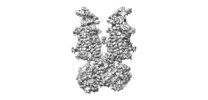


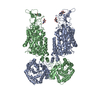
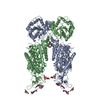
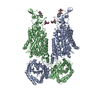

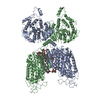
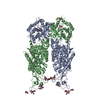


 Z (Sec.)
Z (Sec.) Y (Row.)
Y (Row.) X (Col.)
X (Col.)





















